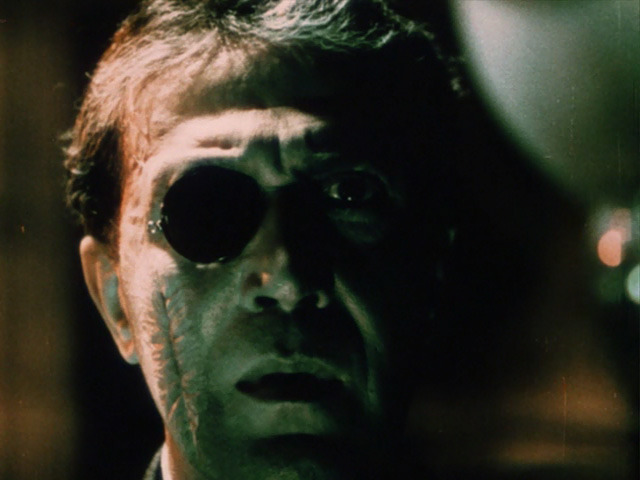To get you into the Halloween spirit, here are five film recommendations filled with enough blood, screams and creepiness to make October 31 all the more atmospheric. Spanning half a century of filmmaking, from an early Hollywood talkie of the 1930s to a lustful semi-classic of the vampire genre made in the 1980s, each of these films will impress you with both style and substance.




Doctor X (1932, dir. Michael Curtiz) – The early use of two-strip Technicolor, photographed by Ray Rennahan, gives an eerie red-and-green glow to the proceedings in this tale of mad scientists and serial killers. Fay Wray, who would soon become immortalized in film history as the heroine in King Kong (1933), plays the daughter of scientific research expert Lionel Atwill, who is convinced he can figure out the identity of “The Moon Killer” stalking New York. The pair are aided by Lee Tracy in one of his typically lively newspaperman roles, providing a romance subplot. Atwill’s fellow doctors are played by Preston Foster, Arthur Edmund Carewe, John Wray and Harry Beresford.




Cat People (1942, dir. Jacques Tourneur) – Produced by the legendary Val Lewton, this classic tale stars Simone Simon as a woman who falls under the spell of a panther in the local zoo. Kent Smith plays Simon’s love interest (later, husband), while Jane Randolph is one of Smith’s coworkers who is also in love with him. Some notable character actors pop up in uncredited roles: Elizabeth Russell as the “Cat Woman” who recognizes a kindred spirit in Simon; Alan Napier as a doctor; Theresa Harris as a café waitress. Nicholas Musuraca’s crisp black-and-white cinematography enhances the tension, especially in a scene in which Jane Randolph fears she is being followed on her walk home and in another scene in which Randolph is alone (or is she?) in a hotel swimming pool. Shadows populate every corner, emphasizing every possibility of a threat.




The Curse of Frankenstein (1957, dir. Terence Fisher) – Hammer horror is an acquired taste, sometimes too silly to be taken seriously as frightening cinema. But the color photography by Jack Asher, who also worked on such famous films as Horror of Dracula (1958) and The Hound of the Baskervilles (1959), improves the overall quality and there are some splendid costumes designed by Molly Arbuthnot, not to mention the monster makeup created by Philip Leakey. Christopher Lee doesn’t do much beyond the required menace for playing Frankenstein’s monster (how can he, without dialogue?) but he’s always fun to watch. Peter Cushing is also entertaining as Baron Frankenstein, while Hazel Court looks fetching but is given little to do besides play the damsel in distress. Ultimately the film belongs to Christopher Lee as the lumbering, oozing creature.




Daughters of Darkness (1971, dir. Harry Kümel) – Considered a landmark in vampire cinema, this Belgian film concentrates more on eroticism, art direction/set decoration and costume design than it does on actual horror. There is some gore, but the film’s unsettling mood is what really makes it worth watching. Delphine Seyrig plays the ageless Countess Bathory, styled to look a little like Marlene Dietrich. Similarly, her “secretary” Ilona, played by Andrea Rau, has a haircut reminiscent of Louise Brooks. They work together to seduce young newlyweds in an empty European hotel, making great use of the enormous sets and Seyrig’s elegant gowns. The film’s visual appeal owes thanks to cinematographer Eduard van der Enden and it is supplemented by the sinister score composed by François de Roubaix.




The Hunger (1983, dir. Tony Scott) – The greatest of the five films, this exceptionally stylish and sensual vampire story stars Catherine Deneuve and David Bowie as undead lovers who prey upon unsuspecting New Yorkers. Their world is upended by Susan Sarandon as a doctor whose theories on aging are in direct correlation with an affliction happening to Bowie. Now and then some other famous faces appear: Dan Hedaya as a droll detective; the influential gothic rock group Bauhaus performing their song “Bela Lugosi’s Dead” in the opening credits, which take place in a nightclub; Bessie Love as an elderly woman at Sarandon’s book signing; Willem Dafoe in an early role as a punk on the street. Stephen Goldblatt’s cinematography and Milena Canonero’s costumes make Deneuve look the part of eternal beauty, but it’s the unusual editing by Pamela Power that lends an extra special touch, favoring quick cuts and J-cuts (in which the sound from shot B is heard while you’re still looking at shot A, giving you information from the next scene before you have visually arrived). Dick Smith, known as “The Godfather of Makeup,” contributed his skills to The Hunger as well, allowing for the depiction of decades of physical transformation.
